Stockhausen's Studies I and II
Mike Krzyzaniak
Stockhausen's Studie I (Summer 1953) and Studie II (1954) are, pardon me, studies. Specifically, they are studies of a sound generation technique now known as 'additive synthesis', which is defined as the layering of sinusoidal audio signals to produce complex timbres.2 Although Studies I and II are the first musical compositions to employ this technique explicitly,3 the physical groundwork for the technique was laid by scientists in the 19th century. In 1822, the French mathematician Jean Baptiste Fourier discovered that the static temperature distribution on a cool metal plate with a single point-source of steady heat could be described thus:4

This describes the distribution as an infinite series of sinusoids that are harmonically related. Fourier and others then developed computational techniques for separating these harmonically related sinusoids from various complex waves (eventually including sound waves). The acoustic implications of this work were first proposed by Georg Simon Ohm in 1843. In an article entitled "On the definition of sound, along with its theory", He states that "...the elements of a sound ... must have the form a*sin2πmt or a*cos2πmt, ... so that a succession of impressions upon our ears, which is periodic according to the form given here, must also necessarily cause the sensation of a tone."5 This statement, known as "Ohm's Acoustic Law" implies that any complex, periodic timbre can be broken down into individual sinusoidal constituents, according to Fourier's equation, of which the complex timbre is the sum. In 1863, this law was empirically proven by Herman von Helmholtz in his treatise "Lehre von den Tonempfindungen". In a section entitled "Proof of Ohm's Law", Helmholtz describes experiments that employ the principle of sympathetic vibration in the analysis of the frequency content of complex timbres. He concludes that "the human ear perceives pendular [i.e. sinusoidal] vibrations alone as simple tones, and resolves all other periodic motions [i.e. complex timbres] of the ear into a series of pendular vibrations [sinusoids], hearing the series of simple tones which correspond with these simple vibrations."6 In other words, according to this view, the ear itself breaks down complex timbres into their sinusoidal constituents. This implies that the inverse is also true: that when the ear simultaneously receives a number of sinusoids, it will perceive a complex tone.
In his treatise, Helmholtz explores Ohm's law using a number of experiments that are conceptually similar to Stockhausen's additive synthesis techniques in Studie I and Studie II. In the most remarkable of these experiments, Helmholtz actually builds analog sine-wave generators which he uses to additively synthesize complex timbres that imitate various musical sounds. The experiment comprises three parts. First, he uses an array of tuned resonators (now known as Helmholtz resonators) and theoretical analysis to separate the sinusoidal constituents from various musical sounds, like the several vowels made by the human voice when singing, flutes, reed-pipes, bowed strings, piano and so forth. He reports, for instance, that "with the aide of resonators, it is possible to recognize very high partials, up to the sixteenth, when one of the brighter vowels is sung by a powerful bass voice at a low pitch."7 He also quantifies this more precisely with a number of tables that show the relative amplitude of each sinusoidal constituent in various musical sounds.8
In the second part of the experiment, Helmholtz actually invents an analog sine-wave synthesizer, of which this is the technical drawing:9
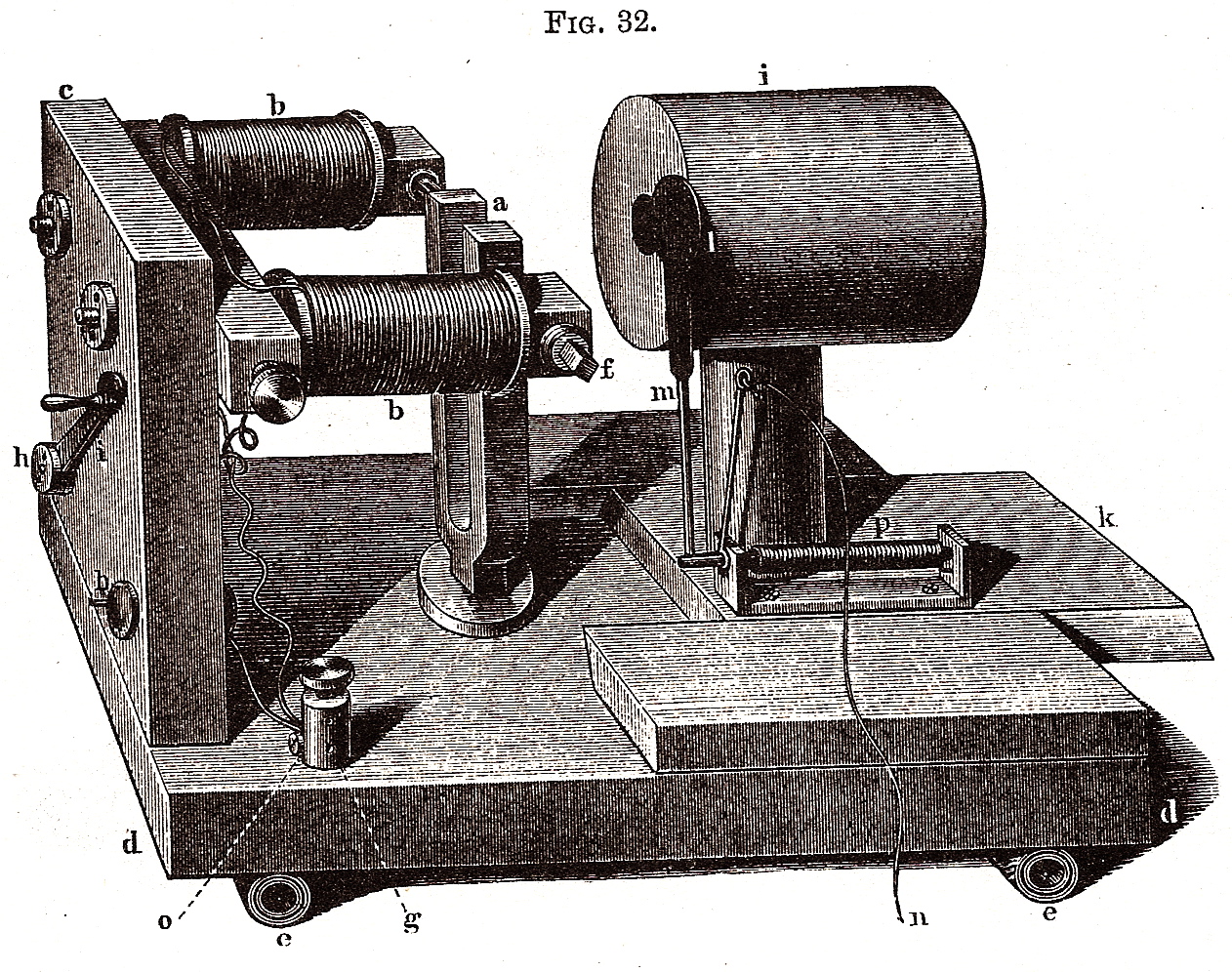
The sound-producing mechanism is a tuning fork, a, which is held in constant vibration by electromagnets, b. Because the tuning fork alone is scarcely audible, the device also contains a resonating chamber, i, which serves to amplify the sound of the tuning fork. The phase and amplitude of the generated sine-waves can be controlled by sliding the resonator closer to or farther away from the tuning fork, or by partially covering the aperture at its end. Helmholtz builds several of these instruments, each with a unique pitch, and each being tuned to subsequent partials of the harmonic series whose fundamental is B♭.
In the final part of this experiment, Helmholtz uses his sine wave generators to additively synthesize the sounds that were examined in the first part of the experiment, by combining their sinusoidal constituents in the observed proportions. He reports, for instance, that "The prime tone B♭ of this series when sounded alone, gave a very dull U, much duller than could be produced in speech. The sound became more like U when the second and third partial tones b♭ and f' were allowed to sound feebly at the same time."10 He continues with other sounds: "The nasality of the clarinet was given by using a series of unevenly numbered partials, and the softer tones of the horn by the full chorus of all the forks."11
Stockhausen begins his electronic studies with a research question identical to Helmholtz's. In his notes from the period, Stockhausen contemplates: "The wave-constitution of instrumental notes and the most diverse noises are amenable to analysis with the aid of electro-acoustic apparatus: is it then possible to reverse the process and thus to synthesize wave-forms according analytic data? To do so one would ... have to take and combine simple waves into various forms..."12 This question is an exact description of parts one and three of Helmholtz's experiment (separated here by the colon), followed by a statement of Ohm's law (after the question mark). In Studie I, Stockhausen, like Helmholtz, attempts to answer this question by synthesizing complex timbres using the harmonic series as a starting point. In Stockhausen's tone combinations, however, although each pair of notes belongs to the same harmonic series, all of the constituents do not. For instance, the first mixture in the piece comprises sine waves whose frequencies are 1920, 800, 1000, 625, 1500, 1200 Hz13. 1920 and 800 are the 12th and 5th partials of a tone whose fundamental is 160Hz, and 800 and 1000 are the 4th and 5th partials of a tone whose fundamental is 200Hz, but all six sine-waves, taken together, do not share a common fundamental14. In Studie II, Stockhausen goes a step further and breaks all ties with the harmonic series. Instead, he uses combinations of 5 sine waves whose frequencies are related to one another by the 25th root of various powers of 515 (which forms a scale whose basic interval is about 111.451378 cents, or just bigger than a semitone, and which does not repeat at the octave). Furthermore, in Studie II, rather than combining the sine waves directly, he plays them in rapid succession into a reverberation chamber and uses the ensuing compound echo as his musical material. In choosing to abandon the harmonic series and diffuse the tones through a reverberation chamber, Stockhausen relinquishes the possibility of using additive synthesis to recreate traditional musical sounds (as Helmholtz did), but simultaneously opens the possibility of creating hitherto unheard timbres.
TECHNICAL AND ÆSTHETIC VIEWS FROM STOCKHAUSEN SCHOLARSAmongst Stockhausen scholars, there seems to be a general consensus that Studies I and II are a technical and æsthetic failure. One of Stockhausen's stated goals each piece was to create "an extreme homogeneity of the basic sounds" of the piece16. Robin Maconie, however, feels that both pieces fail to achieve this timbral homogeneity. From a technical perspective, Stockhausen's equipment was not accurate enough to allow him to control the phase relationships of the individual sine waves. Maconie claims that the lack of control of phase prevented Stockhausen from creating unified timbres in Studie I. He says that "Until the experiment had been tried ... it was easy for composers to hope that the differences in the phase relationship of partials would not greatly affect the tone quality." He says that Stockhausen "may have been puzzled, not to say disappointed, at having had only qualified success in fusing synthetic partials into coherent, unified tone-colors. Whether or not Meyer-Eppler was able to identify the source of the problem as phase-relationship is difficult to know for certain... It is possible that he did not realize how important a factor it was in timbre-synthesis..."
I propose that Maconie may be putting too much weight on the role of phase in additive synthesis. Helmholtz was also interested in the question of phase, and firmly opposes Maconie's view. He says: "I have thus experimented upon numerous combinations of tone with varied differences of phase, and I have never experienced the slightest difference in the quality of tone."17 He then declares that the timbre of a complex tone is in no way dependent upon the phase of its sinusoidal constituents. Although this is not, strictly speaking, true in all cases, modern acousticians agree that "for most complex sounds, the amplitudes of the harmonics have more influence than their phases in determining what we hear..."18. In any event, a simple experiment will determine whether this principle holds true in Studie I. Here I have used a program written in C to cause a digital computer to create two audio files. Each contains a 3 second mixture of 6 sine-waves of equal amplitude. The frequencies of the sine waves are 1920, 800, 1000, 625, 1500, and 1200 Hz, in accordance with Stockhausen's usage in Studie I. In the first file, all of the sinusoids are in phase, and begin at 0 radians at the beginning of the file. In the second file, the phases of the sine waves were randomly chosen to begin at approximately 0.843991, 4.206231, 5.705825, 3.048656, 1.869836, and 5.057321 radians, respectively. Here is a plot of the beginning of the waveform (sound-pressure on the ordinate plotted as a function of time on the abscissa) of each of the generated audio files:
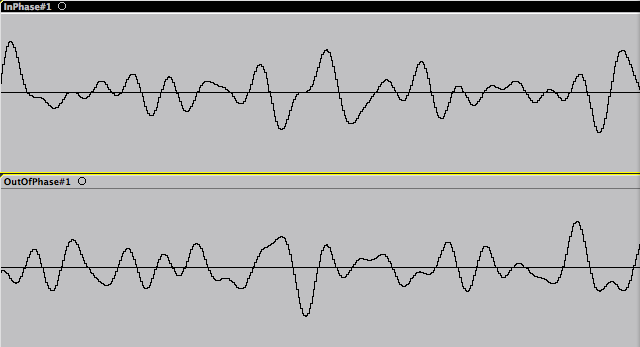
This clearly shows a unique waveform in each file (as would be expected because of the phase difference). Nonetheless, the "in phase" and "out of phase" versions of the note mixture are aurally indistinguishable. From this it may be concluded that, if Studie I lacks timbral homogeneity, the reason is probably not phase. One may further raise the question of where, specifically, Maconie hears differences in timbre...
Seppho Heikinheimo also feels that the studies are a failure, and focuses on æsthetic issues rather than technical ones. He feels that both compositions are monotonous and lack interest. He says that Stockhausen's method of composing Studie I, "in which everything is of equal importance gives rise to a host of new problems and even dangers. It easily results in the emergence of an even, monotonous greyness from which the listener finally cannot distinguish anything at all."19. He goes on to say that "...the way the tones are combined can only seem formal and monotonous ... each intuitively differentiated period in the composition resembles all the others..."20. He also feels that Studie II suffers the same defect. He says: "The same critical evaluation of Studie I holds true for Studie II, and the same criticism of of monotony is undoubtedly justified."
Although I consider both works to be a great success, I will, for the sake of completeness, point out a few more technical shortcomings in Studie II which Stockhausen scholars seem to have overlooked. Stockhausen was not only interested in additive synthesis, but also in a related technique now called "subtractive synthesis", which is defined as the use of filters to selectively remove sinusoids of unwanted frequencies from broadband noise. In a discussion of Studie II, he describes his interest in this technique: "An alternative fundamental method of producing electronic sounds is based, not on the addition of sine-wave frequencies... but instead on the separation of 'white noise' into 'colored noise'. Here electric filters are needed to split up the 'white noise' into bands of noise of any given breadth and density... " He then continues by saying that his use of a reverberation chamber in Studie II was an attempt to simulate sounds produced by subtractive synthesis, by adding broadband noise back into the audio signal. He says "In Studie II -- in the absence of sufficiently varied filtering systems, -- a special procedure was adopted ... [which] permitted the incorporation into the composition of the noise spectrum."21 A Fourier spectrogram (amplitude is plotted on the ordinate as a function of frequency on the abscissa) of the opening note mixture of the piece (mixture number 67), however, reveals that there is no broadband noise, aside from some low frequency tape-hiss under approximately 1000 Hz.

Only the original 5 sine waves are visible in this spectrogram. It would therefore be a mistake repeat Stockhausen and say, for instance, that "the use of noise solely as a musical element is the most important feature of Studie II",22 because there is neither noise nor anything else resembling subtractive synthesis.
The spectrogram also reveals another shortcoming. Stockhausen appears to have wanted each sine wave to be equal in intensity. He specifies that "the five frequencies are recorded at 0 dB", and that the reverberation chamber should have a "regular frequency response"23. This spectrogram, however, reveals a sharp roll-off. In fact, the highest sine-wave is barely visible (or audible). It is unknown whether this is the result of poor frequency response of the equipment (the reverberation chamber, microphone, tape machine, the tape itself...), degradation of the tape over time, side effects of modern mastering, or otherwise. In any event, the spectrogram plainly shows an undeniable gap between what Stockhausen set out to achieve and what he did achieve, both in terms of noise spectra and intensity.
PRINTED RECEPTION OF PERFORMANCESIt appears as though performances of Studie I and Studie II did not meet much better reception by the concert-going public than it did by scholars. They were both premiered at a public concert at the WDR in Cologne on October 19, 1954. The German art historian Walter Friedländer was in the audience, and 2 days after the concert he published a newspaper article in which he questioned the validity of Stockhausen's compositional methods. Regarding the concert in general, he asked: "Can the statistical method ... seriously be considered a composition? What is the use of having these complicated mathematical operations for the organization of the material...?"24 Hindemith heard the studies in a later concert at the WDR, and had a much stronger negative reaction than Friedländer. Stockhausen later recalled that, after the concert, Hindemith "did not utter a single printable word, and he went off." Stockhausen continues: "I was deeply shocked, because I respected him as a master craftsman, had played his works and knew and greatly admired Marienleben and Mathis der Maler. I was thus disappointed that this man simply denied my musicality."25 Even Pierre Schaeffer, who was himself a pioneer of highly unconventional musical timbres, was unusually apathetic towards Stockhausen's early attempts at timbre synthesis. In a later interview, he recalls Stockhausen's early experimentation with timbre, during the period that lead up to Studies I and II. He said:
OK, Stockhausen came. He took a tiny bit of sound, about 10 centimeters of tape, and he said; 'I am going to cut this sound into millimeter pieces, and make a permutation out of it.' I said, 'You poor thing, don't do that, you'll only get a load of background noise, and that's just not interesting!' ... He absolutely refused to follow my advice; he did not want any advice at all, and since what he had in mind could be done on his own, I sent him off to the rue Barrault to cut his tape into millimeter fragments. So he got down to the splicing and came back very happy, and we said, 'well, fine, let's have a listen to it.' So we played the tape - it was only 10 centimeters long, perhaps 50 centimeters with the permutations - and all you heard was 'Shuuutt'. He was terribly pleased with it - me, not at all! ...[he] just did not want to listen to any rational view of things...26Although he is referring to an earlier piece, one may speculate that he would have felt the same about Stockhausen's similarly unique and tedius approach in Studies I and II. Incidentally, even Stockhausen himself once had a very negative reaction to a performance of Studie II. Stockholm University had programmed a more modern synthesizer to realize the piece, and they played it for Stockhausen. He later recalled: "I sufferd a terrible shock listening to my Studie II ... It was awful, a farce to say the least ... "27 He said that the music had a "static quality". He blamed this on a sloppy and imprecise realization of the work on the part of the programmers. This may be true, but one also wonders whether, to some degree, hearing the piece in a new context gave him an objective third-person glimpse into his own work. MY RICH DESCRIPTION OF Studie II
Taken purely as a musical composition (rather than a scientific object), Studie II provides a rewarding listening experience, despite its poor reception. Stockhausen, perhaps above all, perpetually preoccupied himself with the task of creating unique timbres, and here he clearly succeeds. The timbres of the sounds are all unified, in the sense that one can easily imagine that they are all coming from the same musical instrument. While listening, it is easy to imagine a large, Dr. Seuss-esque metal contraption being struck, scraped, bowed and rubbed with a variety of wooden, metal, glass and other objects. What makes the experience particularly edifying, however, is the knowledge that these are the sounds of a purely imaginary instrument, and, in fact, no acoustic instrument has ever or will ever be capable of producing them. Around the time that Studie II was composed, the virtuosic-concert-piece-for-solo-instrument was on the rise as a musical form.28 Such pieces are often filled with extended techniques that seek to expand the timbral range of the instrument. Because of its unified timbres, Studie II very much has the 'feel' of such a solo-piece. In a sense, however, Stockhausen has outdone other solo-pieces by extending timbre so far that it actually exceeds the range of any acoustic instrument. Studie II's timbre outdoes other electronic compositions of the period as well. Pierre Schaeffer's compositions from the early 50s, for instance, undoubtedly make bold explorations into timbre, but in his compositions the timbres come from aurally discernible acoustic sources that leave much less up to the imagination.29 His timbres are not new, they are just in a new context. Stockhausen's timbres are new.
Of course, 'unified timbre' is not synonymous with 'monotonous music'. On the contrary, Studie II is filled with a rich variety of musical textures. In the opening section (the first 4 pages of the score), the texture is very thin (the top staff plots frequency as a function of time, and the bottom staff plots amplitude as a function of time):

For the most part, only one note-mixture is sounding at any given time. The envelopes have low peak-amplitudes and medium to long durations. Silence figures prominently in this section as well. This all gives the music a very placid quality, which is appropriate to the beginning of a musical journey.
As the journey continues, it is soon met with action-packed excitement. Perhaps the most exhilarating texture is from page 13-15 of the score, or about 1:20-1:40 in the recording:
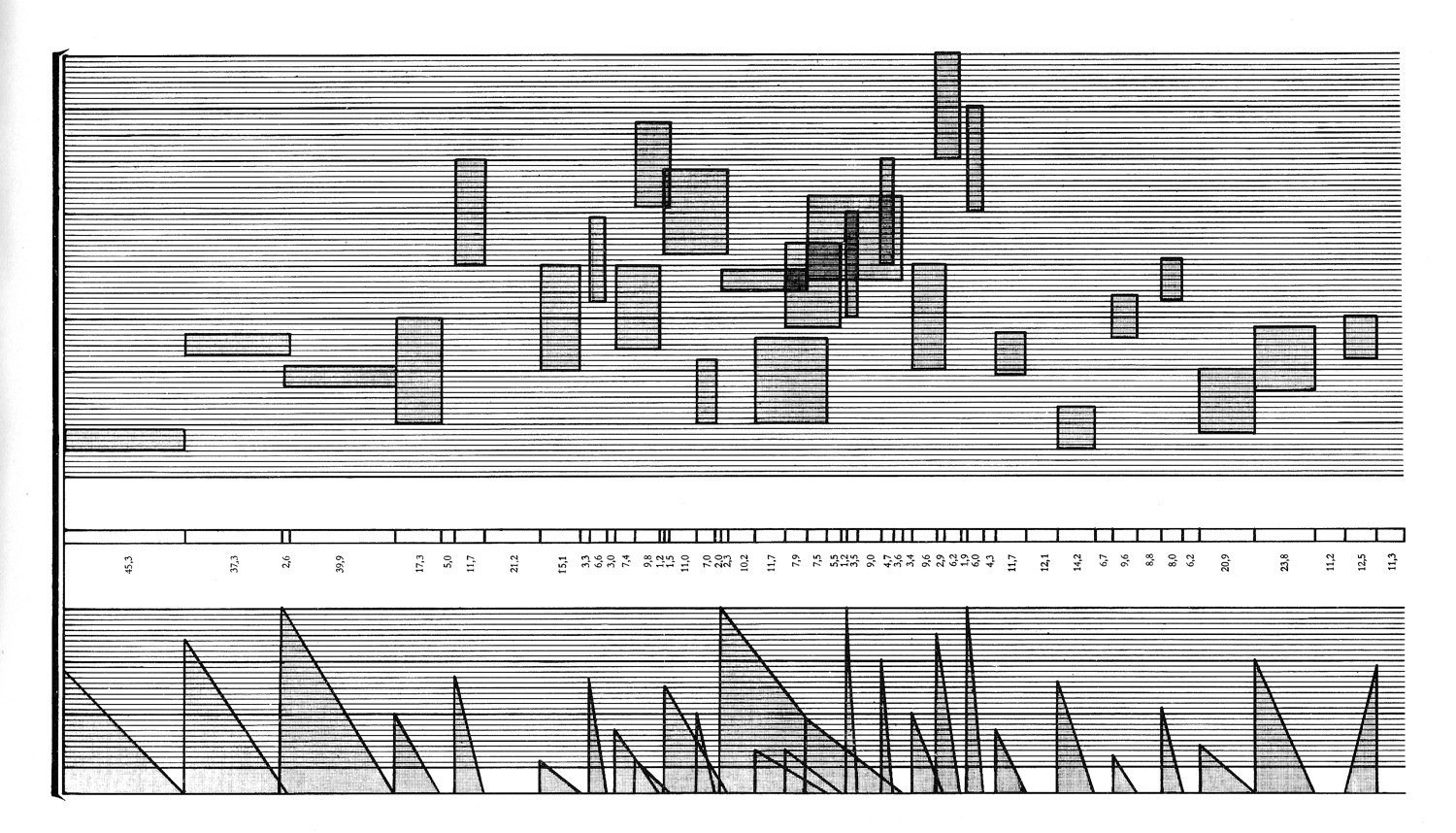
Here, there are lots of note-mixtures in a short span of time. All of the amplitude-envelopes in this section are of the sharp-attack variety, and short in duration. Furthermore, no two attacks are synchronous, yet many note-mixtures overlap others. This gives the thrilling impression of a rapid-fire succession of percussive clangs, pops, peals and tintinnabulations. If the beginning of the piece was like rolling out of bed in the morning and taking coffee with the daily news, then this section is like having your morning stroll met with an unexpected construction zone.
Immediately following this section, he takes the overlapping concept a step further. Here, masses of note mixtures are given envelopes of similar direction (either all ascending or all descending) and varying durations, that either all start or all end together:
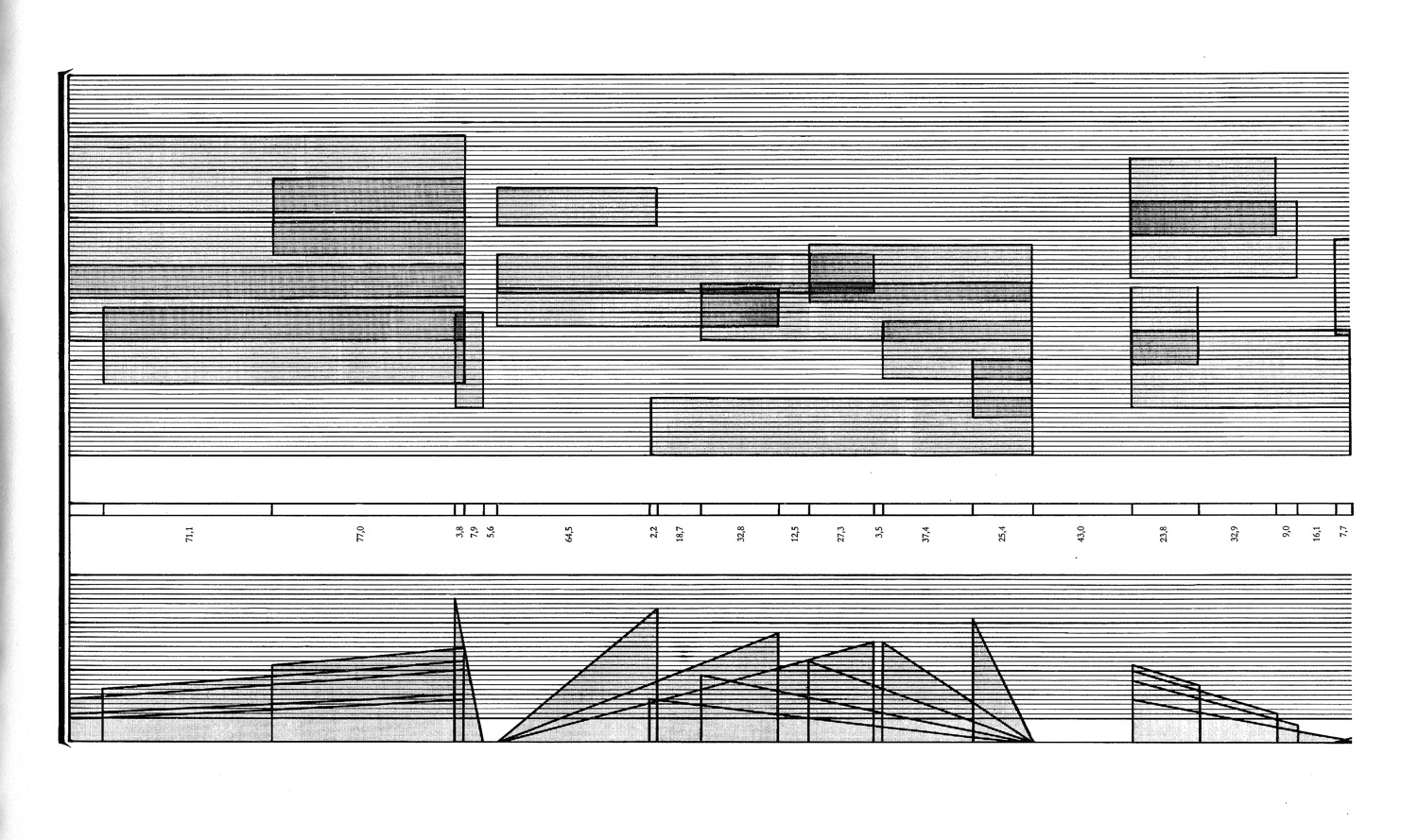
The result is a succession of dense, heavy, climactic, even violent musical gestures.
At the end of the piece there is a return to the sparse musical texture of the beginning:
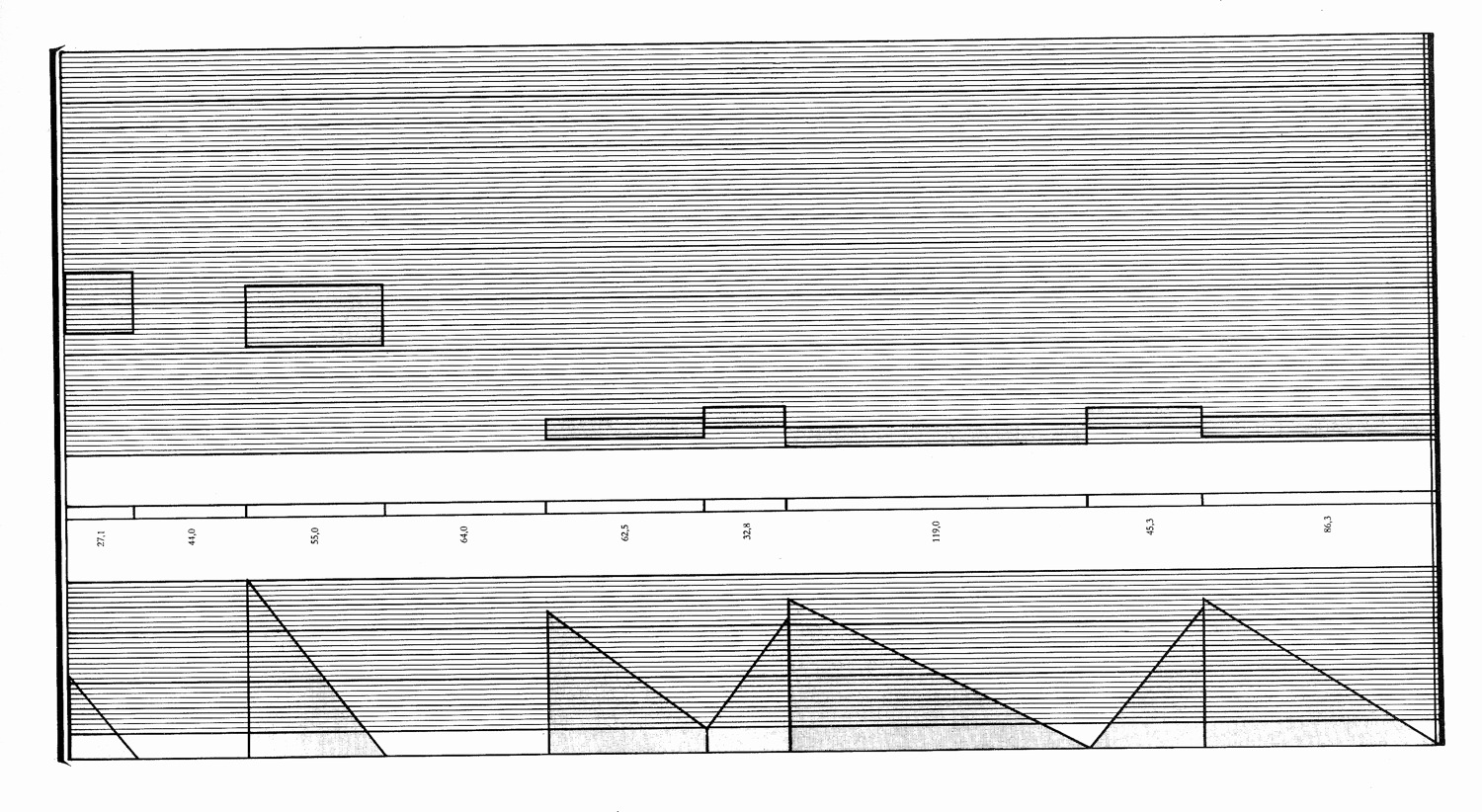
Nonetheless, even this section contrasts the first. Here, the peak amplitude of the envelopes are much louder than in the beginning. The last 5 notes are all very low in pitch and narrow in bandwidth. Their amplitude envelopes are aligned back-to-back, so that the long attack of one is butted against the long decay of the next. This gives the impression of a single continuous sound that is reminiscent perhaps of a lion's roar or thunder. So over the course of the piece, the musical textures are continuously changing, and continuously providing the listener with varied and interesting musical material.
Notes
- For a much more traditional and comprehensive biography of the works, the sole reader of this paper is directed to: Michael Kurtz, Stockhausen: a Biography, tr. Richard Toop. (London: Faber and Faber, 1992), 58-78. Here, I will focus on the less well-explored side of the pieces' history.
- "This combining of multiple sine-wave frequencies to form unusual spectra or tone mixtures is referred to as additive synthesis, and is a feature of tape music produced in the studio. This technique demands a bank of oscillators, though in the earliest pieces from Cologne, recourse was made to multiple recording techniques to achieve a multiple sine-wave mixture." Gustav Ciamaga, The Tape Studio. Published in John Appleton, The Development and Practice of Electronic Music. (Upper Saddle River, New Jersey: Prentice Hall, Inc., 1975), 75.
- ...at least according to Stockhausen, who claims that "Studie I is the first composition to use sine-wave sounds." This would also make it the first piece to use additive synthesis. The quote is from: Karl Wörner, Stockhausen Life and Works, tr. Bill Hopkins. (Berkeley: University of California Press, 1973), 32. Wörner does not cite the source of the quotation.
-
Fourier states this equation with a slightly different notation:
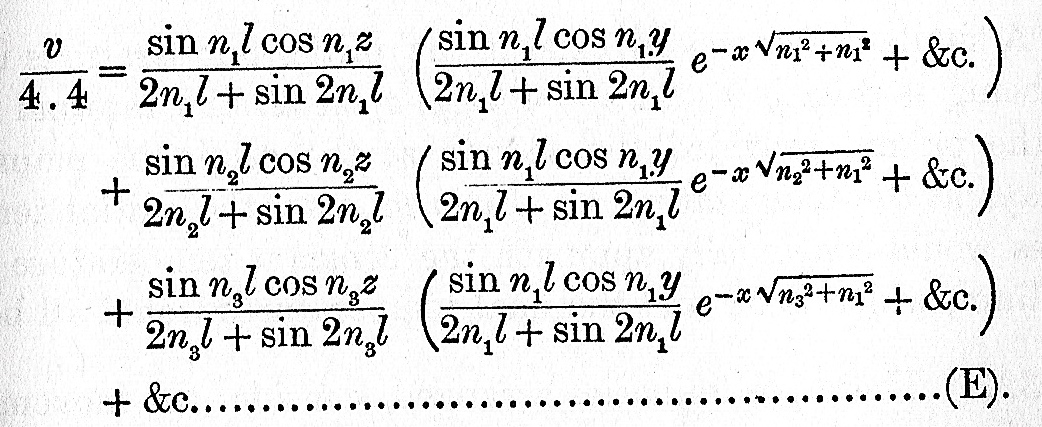
Joseph Fourier, Analytical Theory of Heat, tr. Alexander Freeman. (New York: Dover Publications Inc., 1955), 315. The notation printed in the body of the text, which is somewhat easier to understand, is from Wikipedia. http://en.wikipedia.org/wiki/Fourier_series#Example_2:_Fourier.27s_motivation (Internet: accessed April 24, 2011). -
The original statement:
"Ich hatte nämlich dabei stets als ausgemachte Sache vorausgesetzt, dafs die Bestandtheile eins Tones, dessen Schwingungsmenge m seyn soll, die Form a*sin2πmt oder a*cos2πmt einhalten müssen, worin t die Zeit und a die Schwingungsweite für die aufeinander folgenden Tonelemente bezeichnen, und umgekehrt, dafs eine Succession von Eindrücken auf unser Ohr, welche ununterbrochen die hier ausgestellte Form einhält, auch nothwendig die Empfindung eines Tons bewirken müsse."
Georg Simon Ohm, "Ueber die Definition des Tones, nebst daran geknüpfter Theorie der Sirene und ähnlicher tonbildender Vorrichtungen," Annalen der Physik 135 no. 8 (1843): 513. - Herman Helmholtz, On the Sensations of Tone as a Physiological Basis for the Theory of Music, tr. Alexander J Ellis. (London: Longmans, Green, and Co., 1948. Translated from the 4th German Edition), 56
- ibid., 103.
-
To demonstrate his comprehensive and scrupulous scientific approach, I provide this table of the overtone content of piano strings:
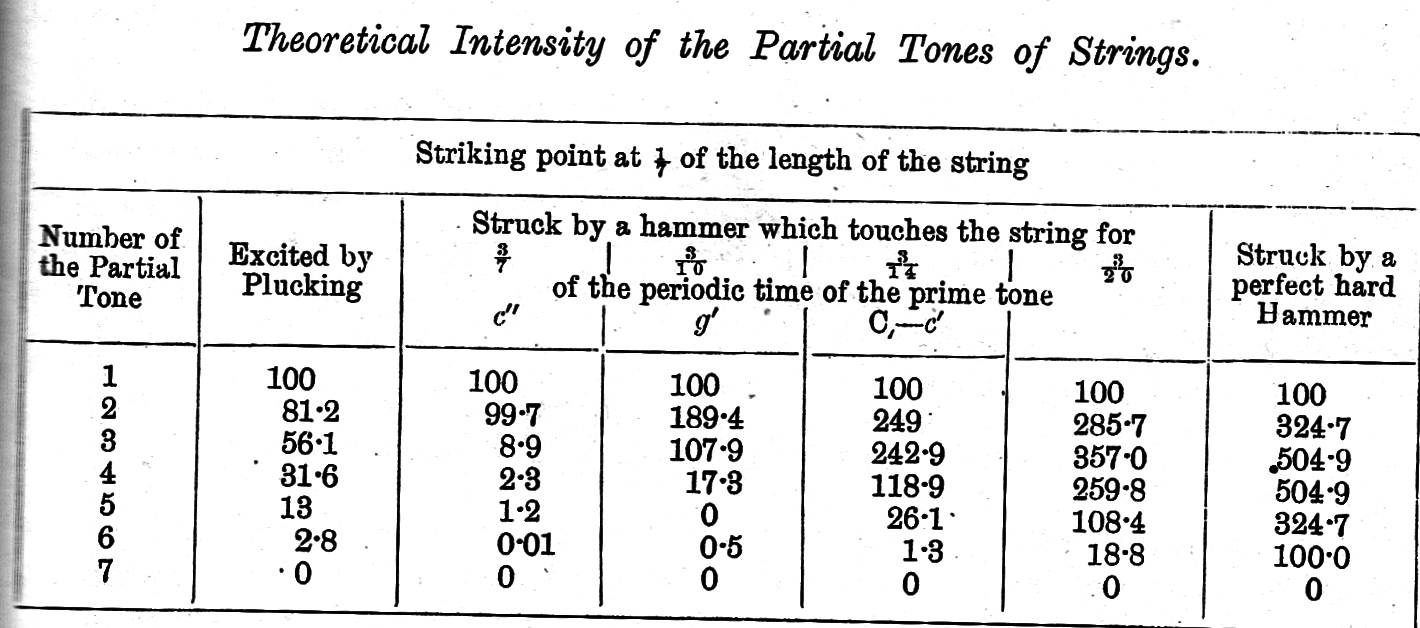
ibid., 79. - ibid., 121.
- ibid., 123.
- ibid., 124.
- Originally in: Karlheinz Stockhausen, Texte Band I: sur elektronischen und instrumentalen musik. (Köln: DuMont Schauberg, 1964), 37-38. The English translation taken from: Robin Maconie, The Works of Karlheinz Stockhausen. (London: Oxford University Press, 1976), 71.
- Seppo Heikinheimo, The Electronic Music of Karlheinz Stockhausen, tr. Brad Absetz. (Helsinki, Finland: Suomen Musiikkitieteellinen Seura, 1972), 26.
- For the sake of completeness, I will point out that they could belong to an harmonic series whose fundamental is 5Hz or 1Hz (or 0.5 Hz, etc...), but these are trivial cases: It seems like a stretch to attempt to claim that 1920Hz is the 384th partial of an inaudible tone.
- This is explained in detail in the front-matter to the score. Karlheinz Stockhausen, Studie II. (London: Universal Edition, 1956), I-VII.
- Wörner, 33.
- Helmholtz, 126.
- W. Lawerence Gulick, George A. Gescheider and Robert D. Frisina, Hearing: Physiological Acoustics, Neural Coding, and Psychoacoustics. (New York: Oxford University Press, 1989), 36.
- Heikinheimo, 39.
- ibid., 41.
- Wörner, 33. He does not cite his source.
- I do not mean to pick on the author, but this particular misconception came from: Heikinheimo, 39. It is a popular misconception restated in almost every treatment of the work.
- Stockhausen, Studie II, VII.
- Originally in: Friedländer, Walter. "Debut der elektronischen Musik." Frankfurter Allgemeine Zeitung October 21, 1954. Taken From: Heikinheimo, 35.
- Originally in: Karlheinz Stockhausen, "Ein Gespräch über die Donaueschinger Musiktage" Almenach 1990, series 14: 220-230. Translation taken from: Michael Kurtz, Stockhausen: a Biography, tr. Richard Toop. (London: Faber and Faber, 1992), 66.
- Originally in: Michael Kurtz, "Interview mit Pierre Schaeffer", Zeitschrift für Musikpädagogik, 33 (January 1986): 16-17. Translation taken from: Kurtz, Stockhausen: a Biography, 55-56.
- Mya Tannenbaum, Conversations with Stockhausen, Tr David Butchart. (Oxford: Clarendon Press, 1987), 22.
- Berio's 1958 flute sequenza comes to mind as a shining example from the period.
- The "Cinq études de bruits" (1948), for instance, features recognizable recordings of a train, toys, sauce pans, coughing and the like. His complete works are available on disc. Pierre Schaeffer, L'Œuvre Musicale. (MUSIDISC 292 572).
Bibliography
- Appleton, John, editor. The Development and Practice of Electronic Music. Upper Saddle River, New Jersey: Prentice Hall, Inc., 1975.
- Chadabe, Joel. Electronic Sound. Upper Saddle River, New Jersey: Prenice Hall, 1997.
- Fourier, Joseph. Analytical Theory of Heat. Translated by Alexander Freeman. New York: Dover Publications Inc., 1955.
- Gulick, W. Lawerence, Gescheider, George A, and Frisina, Robert D. Hearing: Physiological Acoustics, Neural Coding, and Psychoacoustics. New York: Oxford University Press, 1989.
- Heikinheimo, Seppo. The Electronic Music of Karlheinz Stockhausen. Translated by Brad Absetz. Helsinki, Finland: Suomen Musiikkitieteellinen Seura, 1972.
- Helmholtz, Herman. On the Sensations of Tone as a Physiological Basis for the Theory of Music. Translated by Alexander J Ellis. London: Longmans, Green, and Co., 1948. Translated from the 4th German Edition.
- Kurtz, Michael. Stockhausen: a Biography. Translated by Richard Toop. London: Faber and Faber, 1992.
- Kurtz, Michael. "Interview mit Pierre Schaeffer", Zeitschrift für Musikpädagogik, 33 (January 1986): 16-17.
- Maconie, Robin. Other Planets. Lanham, Maryland: The Scarecrow Press Inc., 2005.
- Maconie, Robin. The Works of Karlheinz Stockhausen. London: Oxford University Press, 1976.
- Meyer-Eppler, Werner. Grundlagen und Anwendungen der Informationstheorie Berlin: Springer-Verlag, 1969.
- Meyer-Eppler, Werner. "Statistic and Psychologic Problems of Sound," Die Reihe (English Edition) 1 (1958): 55-61.
- Ohm, Georg Simon. "Ueber die Definition des Tones, nebst daran geknüpfter Theorie der Sirene und ähnlicher tonbildender Vorrichtungen," Annalen der Physik 135 no. 8 (1843): 513-565.
- Stockhausen, Karlheinz. "Actualia," Die Reihe (English Edition) 1 (1958): 45-51.
- Stockhausen, Karlheinz. Studie II. London: Universal Edition, 1956.
- Stockhausen, Karlheinz. Texte Band I: sur elektronischen und instrumentalen musik. Köln: DuMont Schauberg, 1964.
- Tannenbaum, Mya. Conversations with Stockhausen. Translated by David Butchart. Oxford: Clarendon Press, 1987.
- Wörner, Karl. Stockhausen Life and Works. Intorduced, translated and edited by Bill Hopkins. Berkeley: University of California Press, 1973.